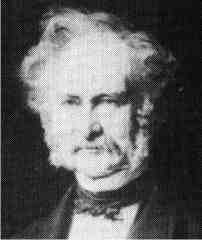Wiggers
WEITER: 46
 |
Peter
Wilhelm
Forchhammer Archäologe * 23.10.1801 Husum + 08.02.1894 Kiel |
|
|
|
Margarethe
Elisabeth Wiggers WEITER: 46 |
||||
|
||||
|
||||
1911
Encyclopedia:"German classical archaeologist, was born at Husurn in
Schleswig on the 23rd of October 1801. He was educated at the Lubeck gymnasium
and the university of Kiel, with which he was connected for nearly 65 years.
In 1830�1834 and 1838�1840 he travelled in Italy, Greece, Asia Minor and Egypt.
In 1843 he was appointed professor of philology at Kiel and director of the
archaeological museum founded by himself in co-operation with Otto Jahn. He
died on the 8th of January 1894. Forchhammer was a democrat in the best sense
of the word, and from 1871 to 1873 represented the progressive party of Schleswig-Holstein
in the German Reichstag. His published works deal chiefly with topography and
ancient mythology. His travels had convinced him that a full and comprehensive
knowledge of classical antiquity could only be acquired by a thorough acquaintance,
with Greek and Roman monuments and works of art, and a detailed etamination
of the topographical and climatic conditions of the chief localities of the
ancient world. These principles are illustrated in his Hellenika. Griechenland.
Im Neuen das Alte (1837), which contains his theory of the origin and explanation
of the Greek myths, which he never abandoned, in spite of the attacks to which
it was subjected. According to him, the myths arose from definite local (especially
atmospheric and aquatic) phenomena, and represented the annually recurring processes
of nature as the acts of gods and heroes; thus, in Aehill (1853), theTrojan
War is the winter conflict of the elements in that district. Other similar short
treatises are: Die Gründung Roms (1868); Daduchos (1875), on the language of
the myths and mythical buildings; Die J�Vanderwngen der Inachostockler Ic (1880);
Prolegomena z�ur Mytliologie als W�tsscnsrhaft und Lexikon der Mythensprache
(1891). Amongst his topographical works mention may be made of: Topogra~hie
von Athen (s841);
......Besckreibung der Ebene von Troja (rS5o),
a commentaty on a map of the locality executed by T. A~ Spratt (see Journal
of the Royal Geograph-ical Society, xii., 1842); Topographia Thebarum Heptapylarum
(1854); Erkiarung der Ilias (1884), on the basis of the topographical and physical
peculiarities of the plain of Troy. His Demokratenbüchlein (1849), in the main
a discussion of the Aristotelian theory of the state, and. Die Athener und Sokrates
(1837), in which, contrary to the almost universal opinion, he upheld the procedure
of ~the Athenians as perfectly legal and their verdict as a perfectly just one,
also deserve notice.
......For a full list of his works see the obituary
notice by E. Alberti in C. Bursian�s Biographisches Jahrbuchfur Altertumskunde,
xx. (.1897); also J. Sass in Allgemeine deutsche Biographic, and A. Hoeck and
L. C. Pertsch, P. W. Forchhammer (1898)."